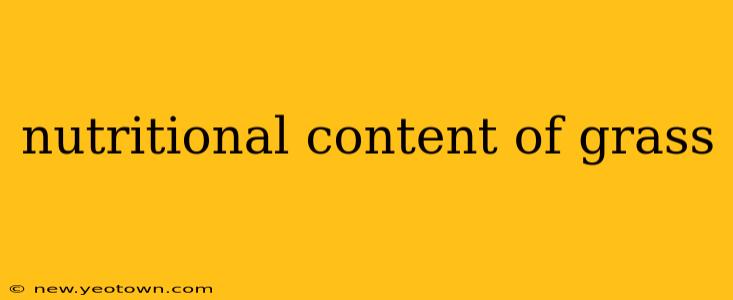Grass. We often overlook it, a simple green carpet beneath our feet. But this unassuming plant is a nutritional powerhouse, especially for the animals that graze on it. Understanding the nutritional content of grass is crucial for anyone interested in animal husbandry, sustainable agriculture, or even simply appreciating the natural world around us. Let's delve into the fascinating world of grass nutrition.
What are the main nutrients found in grass?
Grass, depending on the species, growing conditions, and stage of growth, boasts a surprisingly diverse nutritional profile. Key components include:
-
Carbohydrates: These are the primary energy source for herbivores. Grasses contain various carbohydrates, including cellulose, hemicellulose, and pectin, which are complex sugars that require specialized digestion. The exact composition varies widely depending on the grass type and maturity.
-
Proteins: While not as concentrated as in some legumes, grasses still provide essential amino acids, albeit often in lower amounts than ideal for optimal growth in some animals. The protein content is heavily influenced by factors like fertilization and the growing season.
-
Vitamins: Grasses are a decent source of several vitamins, including vitamins A, E, and K, crucial for various bodily functions. The vitamin content can fluctuate depending on sunlight exposure and soil nutrient levels.
-
Minerals: Essential minerals like magnesium, potassium, calcium, and phosphorus are present in varying quantities. These minerals contribute to bone health, muscle function, and overall metabolic processes.
-
Fiber: Grass is rich in fiber, beneficial for digestive health in herbivores, aiding in regular bowel movements and maintaining a healthy gut microbiome.
How does the nutritional content of grass change with the season?
The nutritional value of grass isn't static; it's a dynamic process affected by the seasons. Spring grass, for instance, tends to be richer in protein and more digestible due to its tender leaves and shoots. As the season progresses into summer, the protein content typically declines, and the fiber content increases, making it less digestible and potentially less palatable. Autumn grass sees a further shift in nutritional composition, with a decrease in overall energy content.
What factors affect the nutritional content of grass?
Several factors influence the nutritional composition of grass, impacting its value as a forage source:
-
Grass Species: Different grass species possess varying nutritional profiles. Some are naturally higher in protein or specific minerals than others.
-
Soil Fertility: Nutrient-rich soil leads to healthier, more nutritious grass. Fertilization practices significantly influence the vitamin and mineral content.
-
Rainfall: Adequate rainfall ensures optimal growth, affecting the overall nutritional quality. Droughts can lead to lower nutrient concentrations.
-
Sunlight: Sufficient sunlight is essential for photosynthesis, impacting the production of carbohydrates and other nutrients.
-
Stage of Growth: The maturity of the grass dramatically affects its nutritional value. Young, actively growing grass is generally more nutritious than mature, seed-producing grass.
How does the nutritional content of grass compare to other feeds?
Compared to other feeds like grains or commercially produced feed, grass generally offers a lower concentration of certain nutrients like protein and energy. However, grass provides a broader range of nutrients and fiber, crucial for the overall health and well-being of herbivores, contributing to a more balanced diet and potentially better overall health outcomes. The nutritional content of grass is complementary to other feeds, rather than a direct replacement.
Is grass a good source of nutrition for humans?
While grass isn't a primary food source for humans, it does contain some nutrients. However, it's low in digestible calories and proteins, making it unsuitable as a significant part of a human diet. Moreover, some grasses contain compounds that can be harmful if ingested in large quantities. It's crucial to note that consuming grass isn't recommended without proper knowledge and preparation.
This exploration into the nutritional content of grass reveals a complex interplay of factors influencing its value as a primary food source for many animals and a valuable component of the ecosystem. Understanding these nuances is essential for sustainable agriculture, animal husbandry, and appreciating the intricate balance of nature.

